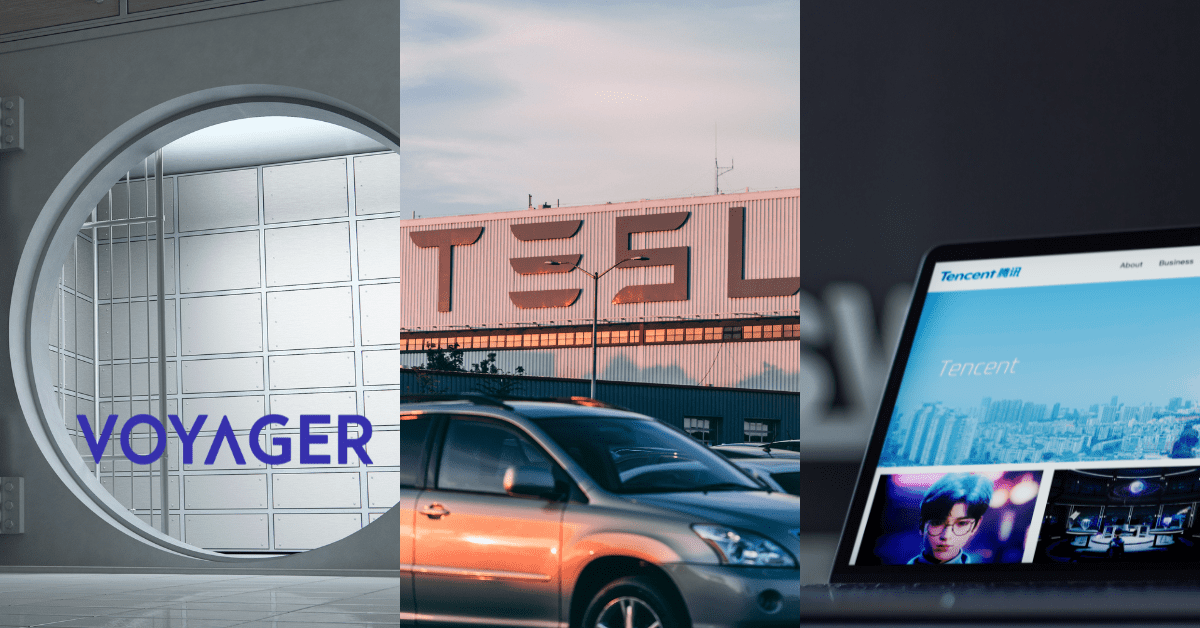In this issue
- Voyager: End of the road?
- Tesla: Cashing out
- Tencent: Foreign shores beckon
From the Editor’s Desk
Dear Reader,
The recent offer by Sam Bankman-Fried’s crypto exchange FTX US and Alameda Ventures to bail out bankrupt crypto lender Voyager Digital may appear to some to be a case of the crypto wunderkind doing at-risk investors a favor. But perhaps SBF’s move might be better characterized as a consolidation.
SBF is a man who has been acquiring troubled crypto companies at a rapid pace, after all. His companies’ increasing control over the industry has dismayed some in the libertarian ranks of the crypto community, who see the potentially democratizing promise of decentralization jeopardized by the growing market power in a dwindling number of hands.
Such concerns and criticism have long been directed at Elon Musk, whose antics in crypto markets have produced outsized price movements that have on occasion cost crypto investors dearly. Like SBF, Musk is in the headlines again, this time after the electric carmaker he founded dumped three-quarters of its Bitcoin holdings into a market that reacted by dropping, and which has continued to do so since.
Both billionaires are variously admired but also disliked, depending on who you speak to, for their exercise of this kind of power — SBF for his hold over increasingly large parts of the crypto industry, and Musk for his preternatural ability to move markets with even the most flippant of gestures.
It’s a well-established fact that capitalist systems tend to foster monopolistic market power if left unchecked, and the crypto industry, as a highly evolved outgrowth of capitalism, is no different. But as the digital asset space continues to mature amid a developing ecosystem of law and regulation — not least in the form of the U.S.’s forthcoming stablecoin bill — will we witness a rejection of such market dominance in the sector? Your move, legislators.
Until the next time,
Angie Lau,
Founder and Editor-in-Chief
Forkast
1. No sale

By the numbers: Sam Bankman-Fried — over 5,000% increase in Google search volume.
Bankrupt crypto brokerage Voyager Digital has described a joint offer by crypto exchange FTX US and Alameda Ventures to save it from insolvency as “a low-ball bid dressed up as a white knight rescue” in documents filed to a bankruptcy court.
- Voyager said the offer was “designed to generate publicity for itself rather than value for Voyager’s customers.” The firm said that was because the proposal was made in a public press release rather than a proper bidding procedure, which could jeopardize any separate bidding process for the company’s assets.
- Voyager last week filed a bidding motion procedure that said the firm “will entertain any serious proposal made pursuant to the Bidding Procedures described in its Motion.” Voyager also claimed in the document that FTX and Alameda had violated their obligations to its debtors and to the bankruptcy court by making the proposal public.
- FTX and Alameda cofounder Sam Bankman-Fried (also known as SBF) pushed back against the criticism on Twitter earlier this week, claiming that lawyers had a vested interest in rejecting the offer as they stood to earn more in fees the longer bankruptcy proceedings took. The billionaire argued that customers should be paid back with the firm’s remaining assets before being further paid with any assets recovered from insolvent crypto hedge fund Three Arrows Capital.
- According to the proposal, announced last Friday, FTX, Alameda and West Realm Shires — which runs FTX US — would purchase all loans and digital assets of Voyager at market value in cash, excluding Voyager’s roughly US$650 million exposure to Three Arrows. The announcement said Voyager customers would be able to open new accounts with FTX with an opening cash balance that would be funded against their bankruptcy claims.
- Voyager’s financial woes are part of a wider contagion brought about by the bankruptcy of Three Arrows, whose significant exposure to Terra before its collapse triggered a domino effect in the crypto industry.
Forkast.Insights | What does it mean?
In two weeks in June, Sam Bankman-Fried went on a shopping spree, the likes of which the crypto industry had never seen. He bought two companies, propped up beleaguered CeFi lender BlockFi and, of course, kept Voyager afloat with a last-minute loan.
Now, SBF wants to add the digital asset lender to his portfolio. To his fans, this is just another example of the billionaire’s altruistic character. But to his critics, it’s another asset-grab by one of crypto’s most powerful players. The details of the Voyager Digital deal reveal that the offer might not be as magnanimous as some people would have us believe.
SBF’s team broke a confidentiality agreement with Voyager by making the proposed deal public, which Voyager’s lawyers described as an “intentional subversion of the bankruptcy process.”
Alameda Ventures, another of SBF’s companies, had borrowed US$377 million worth of crypto from Voyager. Alameda also owns nearly 10% of Voyager’s stock and has offered investors whose money is trapped at Voyager instant payouts, as long as they open accounts with FTX.
If SBF ends up capturing Voyager, he will have warded off the possibility of a rival owning a large slice of his debt. He would also increase his influence over the entire digital asset sector. His subsidiaries have invested in or acquired 20 companies in the crypto space alone. Even fans of SBF are going to have a tough time ignoring that.
2. Turning on a dime

By the numbers: Tesla sells Bitcoin — over 5,000% increase in Google search volume.
Electric carmaker Tesla is making headlines after telling shareholders in a letter that it has sold roughly 75% of its Bitcoin holdings to add US$936 million to its balance sheet. Despite the sell-off, Tesla still holds an estimated 10,800 BTC on its balance sheet — the second-highest figure for a public company and a sum worth about US$230 million as of midweek Asia trading time.
- Tesla announced in February 2021 that it had purchased US$1.5 billion worth of BTC. Two months later, founder and CEO Elon Musk said the company had sold 10% of its BTC holdings. Tesla held an estimated 48,000 BTC before the recent sale.
- Determining what Tesla earned or lost in the sale is difficult. According to an analysis by Bloomberg, Tesla’s balance sheet grew by US$936 million thanks to the BTC sale. The firm also booked a depreciation, amortization and impairment charge of US$922 million, but didn’t break out the line item.
- Tesla CFO Zachary Kirkhorn said the company booked a US$106 million cost in its profit and loss statement, while another letter to shareholders mentioned unspecified restructuring expenses, according to Bloomberg.
- In its letter to shareholders when it announced the sale, Tesla said it had sold the BTC to bolster its cash position amid Covid-related uncertainty.
- “It was important for us to maximize our cash position,: Musk said on an earnings call. “We are certainly open to increasing our Bitcoin holdings in the future, so this should not be taken as some verdict on Bitcoin. It’s just that we were concerned about overall liquidity for the company.”
- Tesla announced it would begin accepting BTC as payment when it first purchased the world’s oldest cryptocurrency, and its subsequent reversal of that decision was a catalyst for a mid-year slump in the crypto market in 2021.
- Bitcoin’s price last week reached a recent peak of more than US$24,000 — the first time it had reached that level since mid-June — just before the news of Tesla’s BTC sale. But its price fell sharply after the news broke and has continued to drop since. As of midweek in Asia trading, Bitcoin had lost more than 10% since that peak and was trading just above US$21,100.
Forkast.Insights | What does it mean?
The motivation for Tesla and Elon Musk’s on-again-off-again relationship with Bitcoin remains unclear, but one thing has become apparent: Crypto is becoming increasingly dominated by whales.
Whenever Musk mentions Bitcoin publicly, its price is affected — by as much as 20% in some cases. At last count, a selection of whales controls 45% of Bitcoin’s entire supply. And BTC is not alone — a growing number of other cryptocurrencies are also seeing increased concentration.
In February last year, Ether’s value fell from US$1,628 to US$700 for a minute on crypto exchange Kraken. The sudden drop appeared to have been connected to a single whale.
Between last October and November, Shiba Inu’s price rocketed, with its market capitalization topping US$20 billion. Researchers found that eight whales controlled 70% of SHIB tokens and had manipulated its price in order to generate massive returns for themselves.
Although such manipulations have become commonplace in crypto, the actions of people such as Musk underscore the likelihood that crypto, without regulation, is on course to become as centralized as TradFi — only without the regulatory checks and balances.
3. Trading places

Chinese tech giant Tencent is planning to lay off an undisclosed number of employees at Huanhe, its non-fungible token (NFT) platform, but remains focused on the overseas NFT business, according to a report by Caixin, a Chinese finance publication.
- Tencent has not issued a public response to reports of the shutdown nor has it responded to Forkast’s inquiries about any plans to develop an overseas NFT market.
- Huanhe is adjusting its development strategy to avoid regulatory risks, according to Caixin.
- Launched last August, Huanhe has grown to become one of the largest NFT marketplaces in China.
- However, Chinese authorities have consistently warned about financial speculation and hype surrounding NFTs, making Chinese marketplaces reluctant to allow secondary trading of NFTs. Huanhe reportedly hasn’t permitted secondary trading.
Forkast.Insights | What does it mean?
It’s understandable that Chinese tech giants in the NFT business might want to pivot to international markets, given the regulatory uncertainty surrounding trading of collectibles in China. As that uncertainty lingers, many Chinese Web 3.0 companies are even relocating overseas.
A Shanghai-based firm that builds communities for NFT projects told Forkast that it was speeding up its relocation to Singapore in pursuit of a better business environment, especially after Covid lockdowns in Shanghai. The company said physical, offline interactions still remained important to its ability to do business.
Bilibili, a video-streaming platform popular with China’s Generation Z, is also taking its NFT business international. In April, it launched a batch of Ethereum-based NFTs for overseas sale, and it is still actively developing an overseas project dubbed “Cheers Up.”
But growing international operations in the NFT market may not be without its challenges. One of the biggest could be China’s capital control measures, wrote Xiao Sa, a Beijing-based lawyer at Dentons Law Office, in a recent research article. NFT platforms might have to allow secondary trading to lure overseas users, which means domestic users might be able to buy NFTs in yuan and sell them to customers abroad for foreign currency or cryptocurrencies. That could raise questions concerning foreign exchange controls, Xiao said.
And Chinese tech firms seeking to take their NFT operations offshore will have to adapt to a completely different blockchain ecosystem, in which public chains comprise the predominant infrastructure. Chinese NFTs, by contrast, are built mainly on consortium chains. Such technical differences, coupled with legal risks, will likely take Chinese companies some time to figure out as they make a push overseas.




